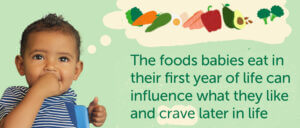blog
U.S.D.A. Says No Added Sugar For Babies & Toddlers

We asked Registered Dietitian, Nicole Silber, RD, CSP, CLC, for her take on the USDA’s 2020-2025 Dietary Guidelines for Americans. Nicole is a board-certified specialist in pediatric nutrition and has worked with hundreds of children with chronic medical conditions, food allergies, picky eating, oral-motor and sensory processing disorders, breastfeeding, gastrointestinal conditions, prematurity and obesity.
For the first time ever, the 2020-2025 Dietary Guidelines for Americans included advice on how to properly feed children under two years of age. Among the guidelines offered to parents and healthcare professionals was a “complete avoidance of all added sugar for children until two years.” Yes, this means avoiding those gleeful gulps of “baby’s first ice-cream” 🍦 and beloved “smash cake,” 🎂 so popular at baby’s first birthday parties. 😥
2 Reasons to Eliminate Foods with Added Sugar from Your Baby’s Diet:

Infants and toddlers undergo growth and development at the fastest pace of the human lifecycle. In addition to rapid growth in their height and weight, children’s immune systems and brains also develop at a critical pace. Children under two have high nutrient requirements for their fast-growing, tiny bodies & bellies. They simply do not have any room in their diet for foods with added sugars, which would likely displace foods with healthy fats, protein, vitamins, minerals, and fiber–foods they need to be eating. If your toddler happily gulps down a bowl of ice cream, she might not be hungry for the foods that will help her grow.

Studies have shown that the foods babies eat in their first year of life can influence their later palates. Taste preferences are formed during this early munching time, so if introduced to very sweet foods, like sweetened cereals or mango juice, infants and young children may crave these sweet foods later in life. The Guidelines also advise to avoid all low and no calorie sweeteners. Their safety for children is still not yet well known. Although they do not displace calories from more nutritionally dense foods, they can also promote a preference for sweet flavors later.

How are Babies & Toddlers Eating Added Sugars??
Unfortunately, research (NHANES 2007-2016) has shown that children ages 12-23 months simply eat too much sugar. On average, children 12-23 months are eating 100 calories per day from added sugar, with a range of 40-250 calories per day. While 100 calories may not sound alarming, it is a high percentage of a toddler’s daily diet, which does not require many calories to begin with. When one converts 40-250 calories of sugar per day into teaspoons of sugar, it amounts to 2.5 – 16 spoonfuls! The biggest culprits are sugar-sweetened drinks that account for 25% of the total sugar intake, and baked goods, like cakes and cookies. Those account for 15% of total sugar intake.
Tips to Curb Your Little’s One Sugar Intake
- Babies begin life already used to sweet flavors, as formula and breast milk are “sweetened” by lactose and other forms of sugars. Once foods are introduced, around 6 months, serve babies a variety of all tastes, specifically savory flavors. Aim to offer more savory foods, like proteins and vegetables, on their own, without always blending them with sweet flavors, like fruits.
- Avoid all juice, even 100% fruit juice, until baby is one. After one, you can introduce limited amounts of 100% fruit or vegetable juice, up to 4 ounces per day.
- Avoid feeding all sugar-sweetened beverages, like soda, sports drinks, fruit punch, and flavored waters. Drinks labeled as fruit drinks or “fruit flavored” drinks are not the same as 100% fruit juice and usually contain added sugar.
- Avoid offering sweetened, plant-based milk alternatives gaining in popularity, such as sweetened oat or almond milks, and toddler formulas with added sugar.
- Read the nutrition facts on the back of food labels. While trying to limit total sugar, specifically focus on the added sugars, which are now listed on a separate row. (Yay!) Choose options that have zero grams of added sugar.
- Read the ingredient lists on the back of food labels and avoid products these ingredients: cane sugar, sugar, honey, maple syrup, brown rice syrup, and high fructose corn syrup.
- When baking for your little ones, substitute added sugars like cane sugar, honey, or maple syrup with mashed fruit, like bananas and apple sauce.
- Choose unsweetened yogurts, cereals, nut butters and granola bars. Most flavored yogurts, including vanilla-flavored yogurts, are sweetened with sugar.
- Replace ice cream with blended frozen fruit made with a splash of milk and vanilla extract.
While the guidelines are clear to eliminate all added sugars until two, it is ultimately a matter of balance and listening to your personal preference! I like to generally avoid added sugar in such young children wherever I can, but sometimes, particularly at special occasions, babies will take a few bites of that smash cake or licks of ice cream. So long as their day-to-day eating is free of added sugar, your baby’s taste buds should be in good shape.
Nicole is the creator of Tiny Tasters, a series of on-demand and live classes that teach parents everything they need to know about how to feed their babies and toddlers. Prior to her current roles she was a clinical nutritionist at the Morgan Stanley Children’s Hospital at New York-Presbyterian/Columbia and at NYU Langone/Fink Children’s Ambulatory Care Center. Nicole lives in New York with her husband and her toddlers, Lily and Luna!
To read more about the Dietary Guidelines for Americans 2020-20205, click here.



